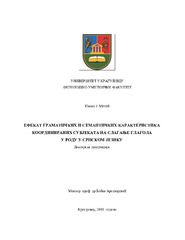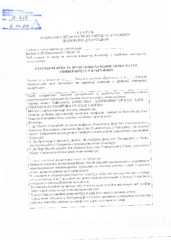Приказ основних података о дисертацији
Ефекат граматичких и семантичких карактеристика координираних субјеката на слагање глагола у роду у српском језику
The effect of grammatical and semantic characteristics of coordinated subjects on verb gender agreement in the Serbian language
| dc.contributor.advisor | Arsenijević, Boban | |
| dc.contributor.other | Kovačević, Miloš | |
| dc.contributor.other | Stanković, Branimir | |
| dc.contributor.other | Vukić, Maja | |
| dc.creator | Mitić, Ivana | |
| dc.date.accessioned | 2020-02-26T15:44:47Z | |
| dc.date.available | 2020-02-26T15:44:47Z | |
| dc.date.available | 2020-07-03T15:24:28Z | |
| dc.date.issued | 2019-07-16 | |
| dc.identifier.uri | https://nardus.mpn.gov.rs/handle/123456789/12005 | |
| dc.identifier.uri | http://eteze.kg.ac.rs/application/showtheses?thesesId=7272 | |
| dc.identifier.uri | https://fedorakg.kg.ac.rs/fedora/get/o:1238/bdef:Content/download | |
| dc.description.abstract | U disertaciji se eksperimentalnom metodom ispituje uticaj gramatičkih karakteristika koordiniranih konjunkata, kao što su vrednost gramatičkog roda, vrednost gramatičkog broja, linearna i hijerarhijska bliskost, kao i semantičkih osobina poput osobina referencije, deljenje modifikatora, na slaganje glagola sa celim koordiniranim subjektom (tzv. razrešeno slaganje), sa prvim konjunktom ili sa poslednjim konjunktom. Cilj je da se dâ model procesiranja slaganja u srpskom jeziku, ali i da se odgovori na značajna teorijska pitanja kao što su da li se slaganje dešava i na interfejsu sa fonologijom, te kakva je međusobna uloga roda i broja u procesu slaganja u srpskom jeziku. Cilj je i da se utvrdi koji faktori utiču na slaganje glagola u rodu sa prvim članom koordiniranog subjekta, kao i da li srpski jezik podržava hipotezu prema kojoj su rod i broj odvojeni i odvojeno učestvuju u procesu slaganja. Kako rezultati sprovedenih produkcijskih eksperimenata i eksperimenata sa sudovima gramatičnosti kojima se testira slaganje glagola sa koordiniranim modifikovanim subjektom pokazuju, slaganje glagola u rodu sa poslednjim članom konjunkcije najčešće je upotrebljen obrazac slaganja. Ovaj obrazac je značajno manje produkovan za uslov u kome je prvi član koordiniranog subjekta modifikovan nego kada je poslednji član modifikovan ili su oba člana modifikovana. Za prvi uslov slaganje glagola u rodu sa prvim članom konjunkcije je značajno više produkovano nego za preostala dva uslova. Kada je linearna distanca između prvog člana konjunkcije i glagola minimizovana, umanjena je šansa da se glagol složi u rodu sa poslednjim članom konjunkcije koji mu je linearno najbliži. Naši rezultati potvrđuju da je linearna distanca faktor koji utiče ne samo na slaganje glagola sa poslednjim članom konjunkcije, nego i na slaganje glagola u rodu sa prvim članom konjunkcije, kao i da hijerarhijska i linearna distanca zajedno određuju izbor kontrolora slaganja u okviru jedne gramatike.10 Rezultati produkcijskih eksperimenata i eksperimenata sa sudovima gramatičnosti kojima se testira efekat sinkretizma na slaganje glagola u rodu potvrđuju da je razrešeno slaganje značajnije umanjeno kada se glagol slaže sa koordiniranim sinkretičnim subjektom mešovitog roda i broja nego kada se slaže sa koordiniranim nesinkretičnim subjektom. Naši rezultati potvrđuju da sinkretizam teži množinskoj interpretaciji, kao i da postoji manja šansa da se glagol složi u rodu sa prvim članom koordiniranog subjekta koji je u množini, nego sa poslednjim članom. Kada je množinski konjunkt na mestu poslednjeg člana konjunkcije, vrednost za broj biva udružena sa efektima koji dolaze iz fonologije (efekat sinkretizma i efekat linearne bliskosti), što jača linearno slaganje, pa je razrešeno slaganje značajnije umanjeno. Rezultati idu u prilog hipotezi da se slaganje dešava i na interfejsu sa fonologijom. U sprovedenom eksperimentalnom istraživanju potvrđena je pojava kombinovanog slaganja na materijalu srpskog jezika, što je suprotno ranijim tvrdnjama Maretića (1899), Korbeta (1983a), Boškovića (2009) za srpski jezik, te Marušiča i dr. (2015) za slovenački jezik, a u skladu sa novijim istraživanjima Arsenijevića i Mitić (2016a) za srpski jezik i Fuhsa i dr. (2015) za španski jezik. Obrazac kombinovanog slaganja, kao obrazac u kome je je kontrolor za slaganje u rodu član ženskog roda u jednini, dok je kontrolor za slaganje u broju u množini, potvrđuje da u srpskom jeziku postoje situacije u kojima vrednost za rod može da prevagne u konkurenciji sa vrednošću za broj. Rezultati idu u prilog hipotezi da su rod i broj u srpskom jeziku odvojeni, i da mogu odvojeno učestvovati u procesu slaganja. | sr |
| dc.description.abstract | This dissertation will use the experimental method to examine the influence of grammatical characteristics of coordinated conjuncts, such as the value of grammatical gender, the value of grammatical number, linear and hierarchical distance, as well as semantic properties such as referential properties, division of modifiers, on the verb agreement with the whole coordinated subject (i.e. resolved agreement), on the first conjunct agreement, or last conjunct agreement. The aim is to give a model for processing agreement in the Serbian language, but also to respond to significant theoretical questions such as whether agreement also occurs in the interface with phonology, and what is the role of gender and number in the process of agreement in the Serbian language. The aim is to also determine which factors influence the verb gender agreement with the first member of the coordinated subject, as well as to determine if the Serbian language supports the hypothesis according to which gender and number are separate and they separately participate in the agreement process. The results of the production experiments and acceptability judgments experiments which test the verb agreement with the coordinated modified subject show that verb agreement with the last conjunct is the most frequently used pattern of agreement. This pattern is significantly less productive for the condition where the first member of the coordinated subject is modified than when the last member is modified, or when both members are modified. For that same condition, the first conjunct agreement is significantly more productive than for the other two conditions. When the linear distance between the first conjunct and the verb is minimized, that also reduces the chances of gender agreement of the verb with the last conjunct which is linearly closest to it. Our results confirm that linear distance is a factor that affects not only last conjunct agreement, but also the verb gender agreement with the first conjunct. The results also confirm that the patterns of agreement compete in determining the agreement controller in the same grammar.12 The results of elicited production experiments and acceptability judgments experiments which test the effect of syncretism on the verb gender agreement show that resolved agreement is more significantly reduced when the last member of the coordinated subject is plural, than when the first member of the coordinated subject is plural. These results confirm that linear distance more significantly reduces the chances of unsuccessful agreement than hierarchical distance. In the conducted experimental research the occurrence of mixed agreement in the Serbian language has been confirmed, contrary to the claims of Maretić (1899), Korbet (1983a), Bošković (2009) for Serbian, Marušić et al. (2015) for Slovenian, and in agreement with recent research conducted by Arsenijević and Mitić (2016a) for Serbian, and Fuchs et al. (2015) for the Spanish language. The pattern of mixed agreement, as a pattern where the controller of the gender agreement is female singular, while the controller for number agreement is plural, confirms that there are situations in the Serbian language where gender value can prevail in competition with the number value. The results support the hypothesis that gender and number are separate in the Serbian language, and that they can separately participate in the agreement process. | en |
| dc.format | application/pdf | |
| dc.language | sr | |
| dc.publisher | Универзитет у Крагујевцу, Филолошко-уметнички факултет | sr |
| dc.rights | openAccess | en |
| dc.rights.uri | https://creativecommons.org/licenses/by-nc-nd/4.0/ | |
| dc.source | Универзитет у Крагујевцу | sr |
| dc.subject | konjunkcijsko slaganje | sr |
| dc.subject | conjunct agreement | en |
| dc.subject | kombinovano slaganje | sr |
| dc.subject | linearna distanca | sr |
| dc.subject | hijerarhijska distanca | sr |
| dc.subject | gramatički rod | sr |
| dc.subject | gramatički broj | sr |
| dc.subject | mixed agreement | en |
| dc.subject | linear distance | en |
| dc.subject | hierarchical distance | en |
| dc.subject | grammatical gender | en |
| dc.subject | grammatical number | en |
| dc.title | Ефекат граматичких и семантичких карактеристика координираних субјеката на слагање глагола у роду у српском језику | sr |
| dc.title.alternative | The effect of grammatical and semantic characteristics of coordinated subjects on verb gender agreement in the Serbian language | en |
| dc.type | doctoralThesis | en |
| dc.rights.license | BY-NC-ND | |
| dc.identifier.fulltext | http://nardus.mpn.gov.rs/bitstream/id/51038/Ivana_Mitic_FIUM.pdf | |
| dc.identifier.fulltext | https://nardus.mpn.gov.rs/bitstream/id/51037/Disertacija.pdf | |
| dc.identifier.fulltext | https://nardus.mpn.gov.rs/bitstream/id/51038/Ivana_Mitic_FIUM.pdf | |
| dc.identifier.fulltext | http://nardus.mpn.gov.rs/bitstream/id/51037/Disertacija.pdf | |
| dc.identifier.rcub | https://hdl.handle.net/21.15107/rcub_nardus_12005 |



